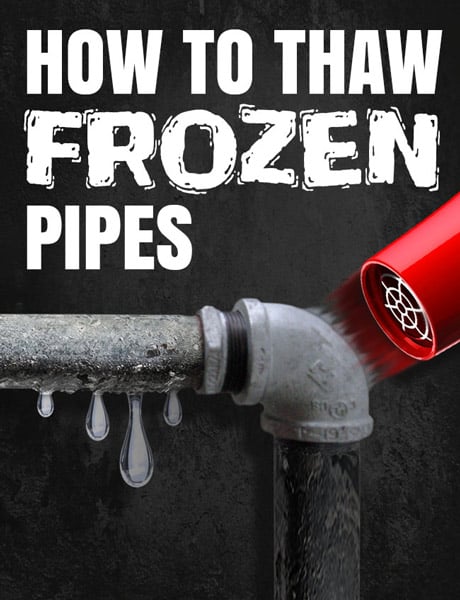
In winter’s frosty grip, our homes become sanctuaries, radiating warmth and comfort. Yet, beneath the surface, the labyrinth of pipes faces a seasonal challenge – the threat of freezing temperatures. Whether you dwell in the snug confines of a house, the modern allure of a condo, or within the bustling walls of an apartment building, understanding the intricate dance of your plumbing is paramount. Frozen pipes can disrupt this delicate harmony, leading to diminished water pressure, elusive leaks, and the ominous watertight seal. Join us in this extensive guide as we embark on a journey to not only thaw frozen pipes but also to prevent damage, ensuring the continued gentle symphony of water throughout your abode.
Section 1: Decoding the Silent Language of Frozen Pipes
Before we immerse ourselves in the art of thawing, let’s decipher the subtle language of frozen pipes. A drop in water pressure, elusive leaks, and faucets rendered silent – these are the cryptic signals your home might be sending. Let’s delve into each of these signs to gain a comprehensive understanding of the cues that signal the need for a thawing intervention.
1.1 Drop in Water Pressure: Unraveling the Mystery
When the once robust stream from your faucets dwindles to a mere trickle, your plumbing is sending an S.O.S. Understanding the dynamics behind this drop in pressure is key to identifying the frozen culprit within your pipes.
1.2 Elusive Leaks: The Stealthy Saboteurs
Leaks can be elusive, silently wreaking havoc within your walls. We’ll explore how to detect these sneaky culprits, ensuring that no hidden leak goes unnoticed during the thawing process.
1.3 Faucets Rendered Silent: The Eerie Hush
Perhaps the most evident sign of a frozen pipe is the silence that greets you when you turn on a faucet. We’ll unravel the science behind this eerie hush, offering insights into what might be happening within your plumbing system.
Section 2: Thawing Frozen Pipes – A Gentle Unveiling for Lasting Solutions
Once the icy culprit has been identified, the delicate process of thawing must commence – a nurturing coaxing akin to awakening a friend from hibernation. Resist the allure of an open flame, for it dances too close to danger.
2.1 The Tools of Thawing: A Comprehensive Arsenal
Equip yourself with these tools, each playing a crucial role in the gentle art of thawing.
- Sheetrock knife
- 5-gallon bucket
- Mop
- Towels
- A defrosting method such as:
- Hair dryer
- Heat gun
- Heat lamp
- Space heater
2.2 Step by Step: A Thawing Odyssey
Guided by patience and precision, the thawing process unfolds step by step. First, turn on the faucet.
2.3 The Science of Heat Application: A Symphony of Warmth
Understanding the science behind applying heat is paramount to thawing pipes effectively. Whether it’s using a hairdryer, heat tape, or a space heater, ensure that your pipes thaw gently and not too quickly. Taking a blow torch to your pipes is going to do more harm than good.
2.4 Post-Thaw Inspection: Unveiling the Aftermath
The battlefield, post-thaw, requires a meticulous inspection. After you’ve dried everything down, use a high-beam flashlight to search for any leaks.
Section 3: Fortifying Your Defenses – How to Prevent Pipes from Freezing
As the saying goes, prevention is better than cure. Shield your pipes against the icy grip of winter with simple and affordable measures. Let’s explore various strategies to fortify your plumbing and prevent future encounters with frozen pipes.
3.1 Insulating Your Home: Blanketing Against the Chill
If the outer walls or basement lack insulation, it’s time to consider investing in this essential shield against the cold. We’ll explore the different types of insulation and guide you on the best practices to keep your home warm and your pipes protected.
3.2 Adding Pipe Insulation: Wrapping Your Pipes in Warmth
A simple yet effective method to protect your pipes is by adding insulation directly to them. We’ll guide you through the process of selecting and installing pipe insulation, ensuring that your plumbing remains cozy even in the coldest of winters.
3.3 Heat Tape: A Warm Embrace for Your Pipes
For an extra layer of warmth, consider using heat tape. This innovative product wraps your pipes in a cozy embrace, heating them with a wire that runs through the tape. We’ll provide a detailed guide on how to use heat tape effectively and keep your pipes snug throughout the winter.
Conclusion: Ensuring a Flowing Haven
Frozen pipes can be a challenge in the intricate dance of household plumbing. But armed with knowledge, tools and action, they don’t have to cause fear of major damage.







